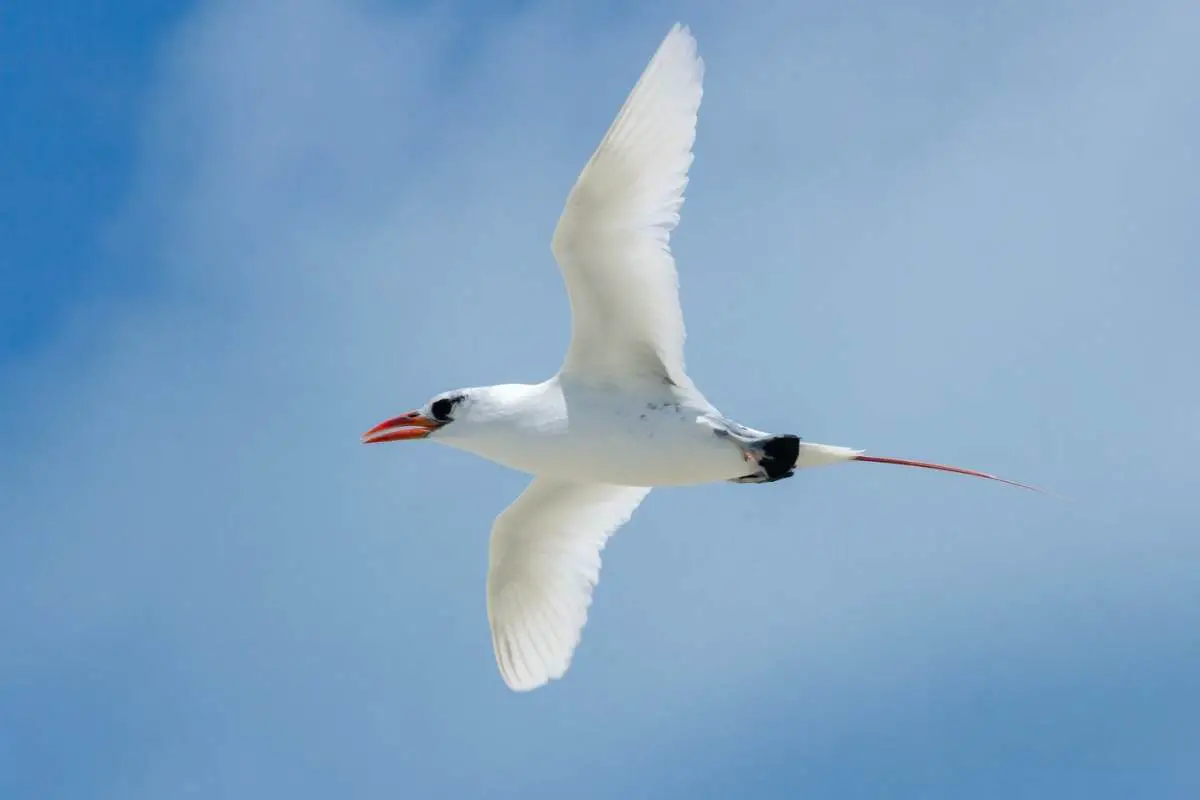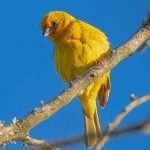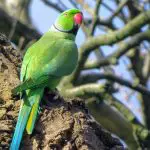Hawaii is home to a wide variety of bird species considering the island’s remote geographic location. Many of these species are unique to the islands, or endemic. Among these are several types of white birds, which are known for their striking plumage and fascinating behaviors.
According to the Hawaii Audubon Society, there are over 300 different bird species that have been recorded on the islands. Of these, several are white birds, including the Nene (Hawaiian Goose), the White Tern, and the Laysan Albatross. Read on to learn about more white bird species in Hawaii!
20 White Birds in Hawaii
The following list contains 20 examples of white birds in Hawaii, which will give you a closer look at their characteristics, habitats, and behaviors. Keep reading to discover more about these striking birds and plan your next bird-watching adventure in Hawaii.
1. White tern
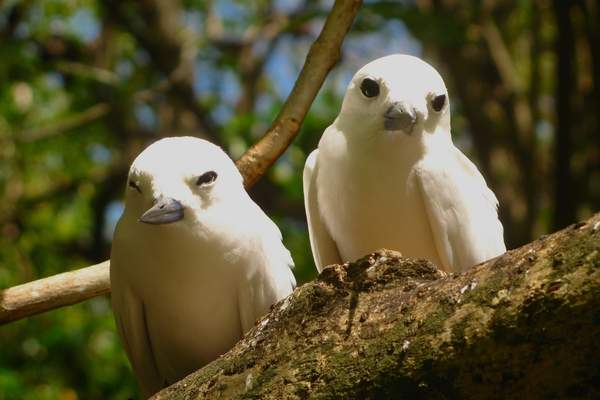
Scientific name: Gygis alba
The White Tern, also known as the Fairy Tern or the White Noddy, is a small seabird that can be found in tropical and subtropical regions across the world. They have a striking appearance, with a pure white plumage, a black eye, and a long, slender bill. Their breeding habits are quite unique, as they are one of the few bird species that lay their eggs on bare branches or ledges, instead of in a nest.
They are also known for their cooperative breeding, where several females may lay their eggs in the same area and share the responsibility of incubation and chick-rearing. The White Tern primarily feeds on small fish, squid, and planktonic crustaceans such as krill and copepods.
In Hawaii, they are commonly found on the main islands, such as Oahu, Maui, and the Big Island, as well as on the smaller islands including Kahoolawe, Lanai, and Molokai. They are often seen in coastal areas and islands, and also in urban areas.
The population of White Terns in Hawaii is considered stable and protected by law. White Terns in Hawaii are protected by the Hawaii Department of Land and Natural Resources (DLNR). However, exact population numbers are not known, but they are generally considered common in the islands.
2. White-tailed tropicbird
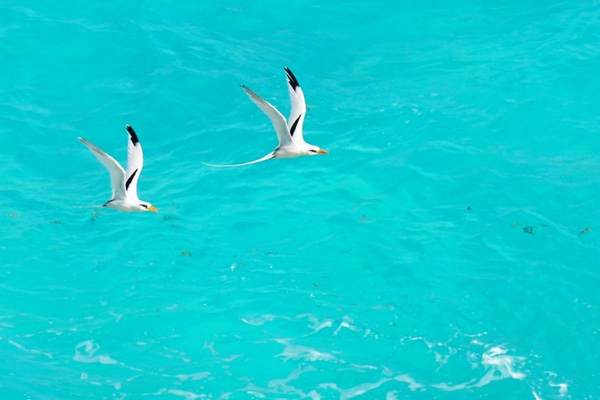
Scientific name: Phaethon lepturus
The White-tailed Tropicbird is a seabird that can be found in tropical and subtropical regions across the world, including the islands of Hawaii. They have a striking appearance, with a long white tail streamers, white plumage, and black wing tips. They have an average length of around 40-43 cm (16-17 inches) and a wingspan of up to 91 cm (36 inches).
The White-tailed Tropicbird primarily feeds on small fish and squid. White-tailed Tropicbird usually hunt during the day, and swallow their prey whole. They are known to fly long distances to find food, sometimes up to 100 km from their breeding colonies.
White-tailed Tropicbird breeding habits are quite unique, as they nest in colonies on offshore islands or cliffs. They usually lay one egg on a small platform of sticks or in a crevice, and both parents take turns incubating the egg and caring for the chick.
In terms of population, White-tailed Tropicbirds in Hawaii are considered stable, however, exact population numbers are not known. They are protected by law, as well as their habitat and breeding areas.
3. Arctic Tern
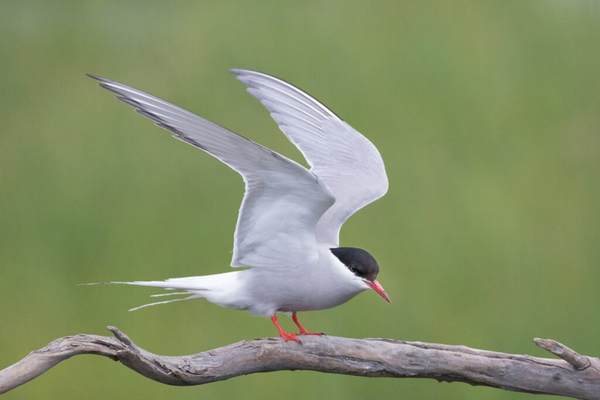
Scientific name: Sterna paradisaea
The Arctic Tern is a migratory species of tern that can be found in Hawaii during its breeding and non-breeding seasons. They are known for their distinctive plumage, with a white body, black cap, and long red bill.
In Hawaii, they can be found mainly on the main islands during the summer months, where they breed and nest on beaches, sandy shores, and coastal areas. Their diet consist mainly of small fish, crustaceans, and marine worms. The population of Arctic Terns in Hawaii is considered stable and they are protected under the Migratory Bird Treaty Act.
4. Red-tailed tropicbird

Scientific name: Phaethon rubricauda
These birds are known for their distinctive appearance, featuring a pure white plumage, a long red tail streamers, and black wing tips, which makes them easy to spot in the wild. They are relatively small birds, with an average length of around 40-43 cm (16-17 inches) and a wingspan of up to 91 cm (36 inches). They primarily feeds on fish and squid.
Red-tailed tropicbird are known to breed in colonies on offshore islands or cliffs, laying one egg on a small platform of sticks or in a crevice, both parents take turns incubating the egg and caring for the chick.
The Red-tailed Tropicbird is an adept flier, able to fly for long periods of time without rest, often seen soaring above the ocean or hovering over the water. Red-tailed Tropicbirds can be found on many islands in Hawaii, including the popular tourist destinations of Oahu, Maui, and Big Island, as well as the lesser-known islands of Kahoolawe, Lanai, and Molokai.
5. Laysan albatross
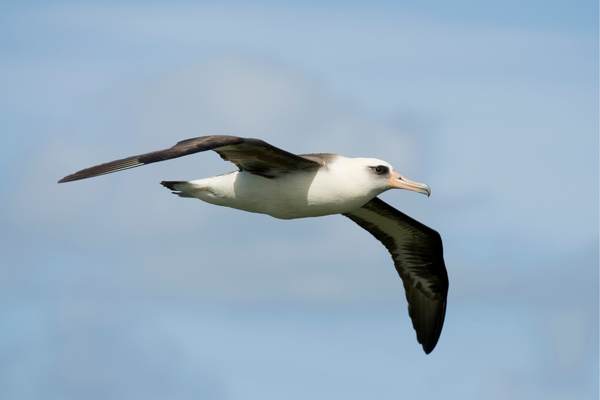
Scientific name: Phoebastria immutabilis
The Laysan Albatross is a large seabird that can be found in the North Pacific Ocean, including the Hawaiian islands. They have a wingspan of up to 2.5 meters (8 ft) and weigh around 4 kg (8.8 lbs). They have a white head and neck, dark brown back and upper wings, and a white underbelly, and a distinctive yellow bill with a dark tip.
Their diet primarily consists of squid and fish, but they also feed on crustaceans, plankton, and carrion. They are known to forage over the open ocean, diving into the water to catch fish, squid and other marine organisms. In terms of breeding, they breed on the islands of Hawaii, primarily on the main islands of Oahu, Maui, and Big Island, as well as on smaller islands like Kahoolawe, Lanai, and Molokai. They nest on the ground, laying one egg and both parents take turns incubating the egg and caring for the chick.
The Laysan Albatross population is considered stable, however the exact numbers are not known. Their population is protected by law and their habitat and breeding areas are also protected, to ensure their survival for future generations.
6. Red-crested Cardinal
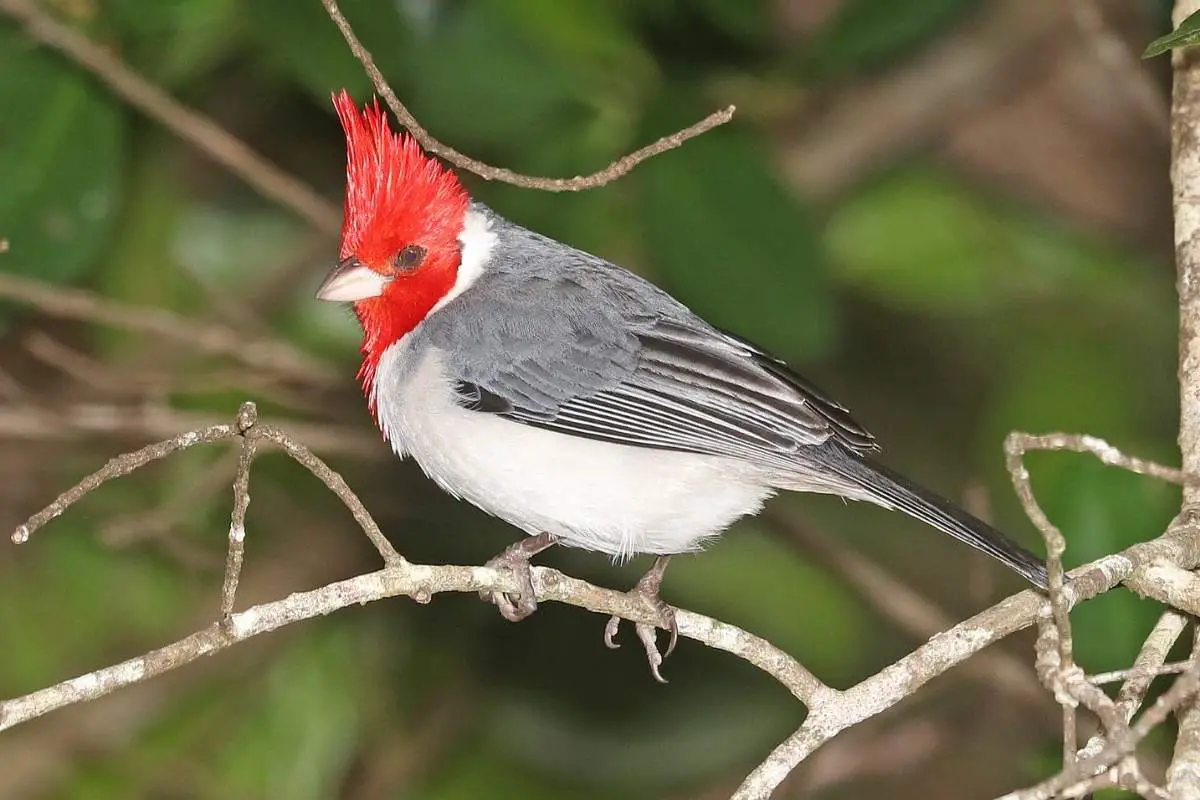
Scientific name: Paroaria coronata
The Red-crested Cardinal, also known as the Brazilian Cardinal, is a species of passerine bird native to South America. They have a striking appearance, with bright red plumage on the head and breast and a black back, wings and tail.
The Red-crested Cardinal are commonly found in Hawaii, where they were introduced in the early 20th century. They can be found in a variety of habitats, such as gardens, parks, and lawns.
They typically breed during the spring and summer months, building nests in trees or shrubs and laying 2-3 eggs per clutch. Their diet consists mainly of seeds and fruits. The population of Red-crested Cardinal in Hawaii is considered stable.
7. Yellow-billed Cardinal
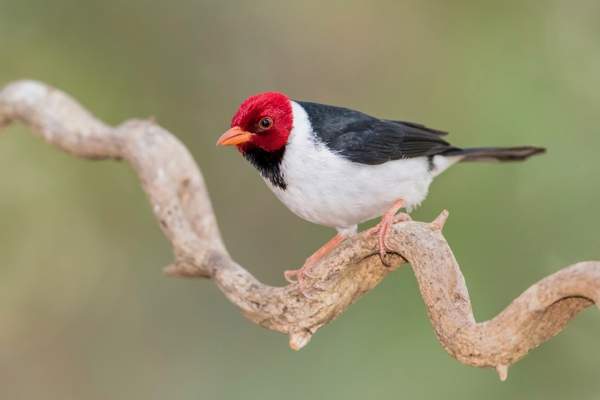
Scientific name: Paroaria capitata
The Yellow-billed Cardinal is a species of bird native to South America. They are characterized by their striking bright red head and yellow bill. They have black upperparts, a partial white collar, white underparts, black chin and throat, and brown-pink legs and feet.
The Yellow-billed Cardinal were introduced in Hawaii in the 1960s, where they are now successfully established and can be found in various places like parking lots, short grassy fields, and shrubby areas across the Hawaiian islands. They feed on seeds and insects and their population is considered stable.
9. Hawaiian Black-necked Stilt
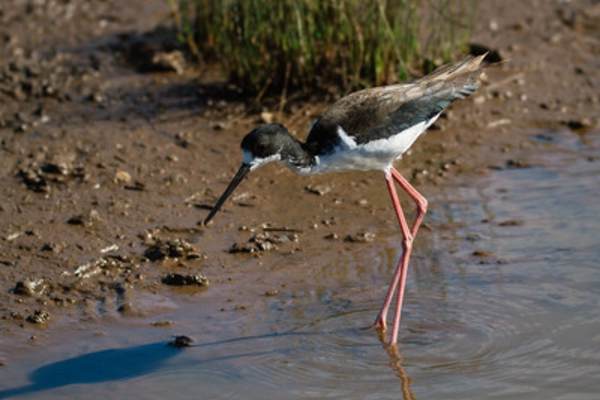
Scientific name: Himantopus mexicanus knudseni
The Hawaiian Black-necked Stilt is a subspecies of the Black-necked Stilt that is found exclusively in Hawaii. They are known for their long pink legs and black and white plumage. They can be found in wetlands, marshes, and coastal areas throughout the main Hawaiian islands, although their population is considered to be endangered.
The Hawaiian Black-necked Stilt typically breed during the spring and summer months, building nests on the ground and laying 3-5 eggs per clutch. Their diet consists of small aquatic animals such as crustaceans and insects. Conservation efforts are ongoing to protect and increase the population of this unique subspecies.
10. Masked Booby
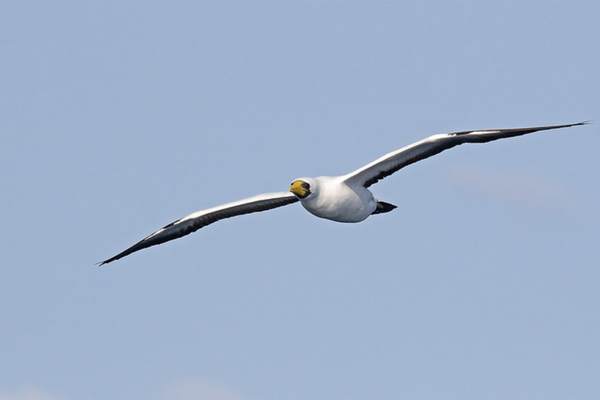
Scientific name: Sula dactylatra
The Masked Booby, also known as the Blue-faced Booby, is a seabird that can be found in the North Pacific Ocean, including the Hawaiian Islands. They have a wingspan of up to 1.5 meters (5 ft.) and weigh around 4.4 lbs. They have a white plumage with a black mask around their eyes and a black tail.
Masked Booby are known for their distinctive blue face and feet. They breed on the islands of Hawaii, primarily on the main islands of Oahu, Maui, and Big Island, as well as on smaller islands like Kahoolawe, Lanai, and Molokai. They are typically found on rocky ledges, cliffs, and islands. Masked Booby feed on fish and squid, diving into the water to catch their prey. The population of Masked Booby in Hawaii is considered stable but exact numbers are not known.
11. Red-footed Booby
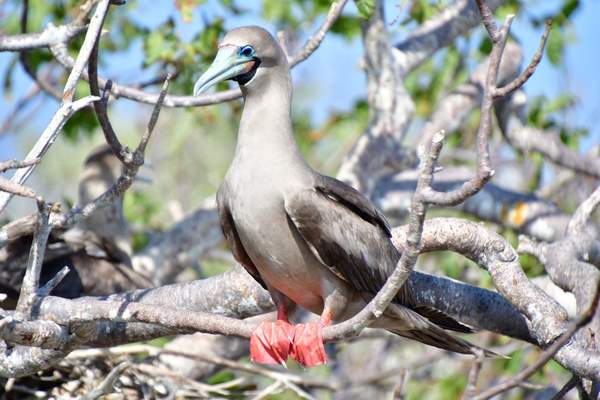
Scientific name: Sula sula
The Red-footed Booby is a seabird species that is native to tropical and subtropical regions of the world, including the Hawaiian Islands. They are known for their distinctive red feet and blue-gray plumage. They have a wingspan of around 4 feet and weigh around 2 pounds.
Red-footed Booby are found in a variety of habitats, including coastal areas, mangroves, and wetlands. They feed on fish, squid and crustaceans. They breed on the islands of Hawaii, primarily on the main islands of Oahu, Maui, and Big Island, as well as on smaller islands like Kahoolawe, Lanai, and Molokai
12. Little Tern
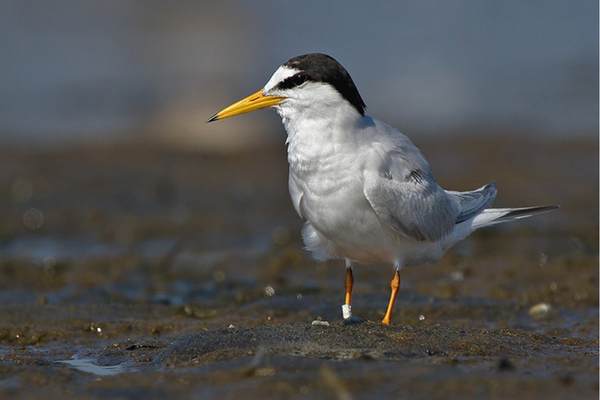
Scientific name: Sternula albifrons
The Little Tern is a small seabird species that breeds along coastal areas in the Northern Hemisphere. In Hawaii, it can be found on the main islands and some smaller islands such as Nihoa, Laysan and Midway. These terns have a distinctive black cap on their head and white plumage.
They typically breed during the spring and summer months, building nests on sandy beaches, and laying one to three eggs per clutch. They feed on small fish and crustaceans which they catch by diving into the water. The population of Little Terns in Hawaii is considered stable, however, their numbers have been declining due to habitat loss and human disturbance.
13. Cattle Egret
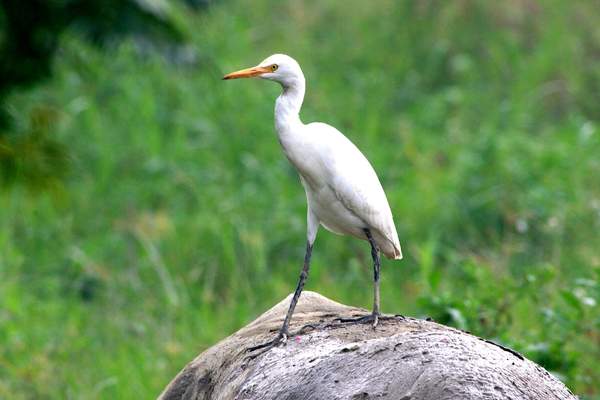
Scientific name: Bubulcus ibis
In the Hawaiian islands, the Cattle Egret is a commonly found species of heron. Its distinguishing features include its white plumage and short yellow bill. These birds have a stable population in Hawaii and breed during spring and summer, constructing nests in trees or bushes and laying 2-6 eggs per clutch.
They are non-migratory and can be observed year-round in Hawaii, inhabiting a variety of habitats such as woodlands, gardens, and wetlands. Their diet includes insects, spiders, crustaceans, and small vertebrates. The population of Cattle Egret in Hawaii is considered stable.
14. Short-tailed Albatross
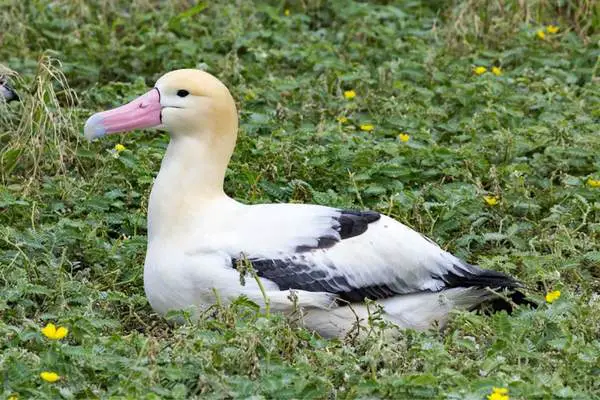
Scientific name: Phoebastria albatrus
The Short-tailed Albatross is a large seabird that can be found in the North Pacific Ocean, including the Hawaiian Islands. They have a wingspan of up to 2.5 meters (8 ft.) and weigh around 8-13 lbs. They have a white plumage with black wingtips and a yellow bill.
Their diet primarily consists of fish and squid, which they catch by diving into the ocean. Short-tailed Albatross breed on the islands of Hawaii, primarily on the main islands of Oahu, Maui, and Big Island, as well as on smaller islands like Kahoolawe, Lanai, and Molokai.
15. Sanderling

Scientific name: Calidris alba
The Sanderling is a small wading bird that can be found in the Hawaiian islands. They are known for their light-colored plumage and short, stocky bill. They have a population in Hawaii and they typically breed during the spring and summer months, building nests on sandy beaches and laying 2-4 eggs per clutch.
The Sanderling is a migratory shorebird that can be found on the Hawaiian islands during the non-breeding season. They are found on sandy beaches and coastal areas, where they feed on small crustaceans and insects. Their population is considered stable in Hawaii, but they are relatively rare. They are often seen running back and forth along the shoreline, chasing the waves as they recede.
16. Bufflehead
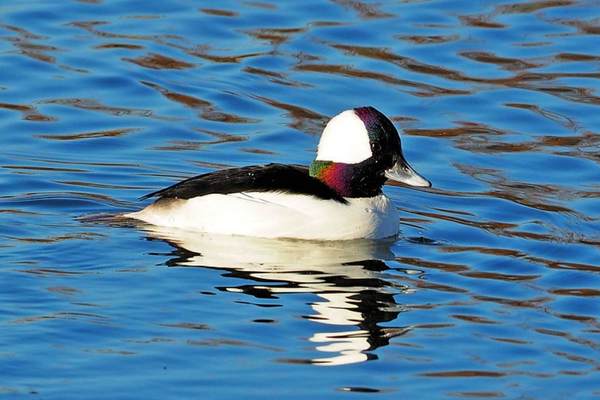
Scientific name: Bucephala albeola
The Bufflehead is a small sea duck that is commonly found in the Hawaiian islands. They are known for their distinctive, round head and iridescent plumage. Bufflehead breed during the winter months and can be found in a variety of habitats, including freshwater wetlands, estuaries, and coastal waters.
They feed on a variety of prey, including aquatic insects, crustaceans, and small fish. Buffleheads are considered non-migratory on the Hawaiian islands, and their population is stable. They can be found on all the main islands of Hawaii, but they are not very common. They are also known to be shy and elusive. Buffleheads are not considered endangered but are under protection due to hunting and habitat destruction.
17. Semipalmated Plover

Scientific name: Charadrius semipalmatus
The Semipalmated Plover is a small shorebird that can be found on the Hawaiian islands during migration. They have a distinctive black band across their forehead and a white belly. Their habitat includes coastal areas such as beaches, mudflats, and estuaries. They feed on small crustaceans, insects, and worms. Breeding typically occurs in the Arctic tundra and they migrate to the Hawaiian islands during the non-breeding season. The population of this species on the islands is considered to be small, and their conservation status is considered to be of least concern. However, habitat loss and human disturbance during breeding and migration may pose a threat to the species.
18. Franklin’s Gull

Scientific name: Leucophaeus pipixcan
Franklin’s Gull is a small, migratory gull species that is not typically found in the Hawaiian Islands. They are known for their black head and wings, white underparts, and gray back. Franklin’s Gull can be found in a variety of habitats such as freshwater marshes, prairies, and fields during the breeding season. They feed on small fish, insects, and crustaceans.
According to the Hawaii Biological Survey, Franklin’s Gull has been recorded as a rare visitor to the Hawaiian Islands. They are known to breed in North America, primarily in the Great Plains, and migrate to South America for the winter.
19. Ring-billed Gull
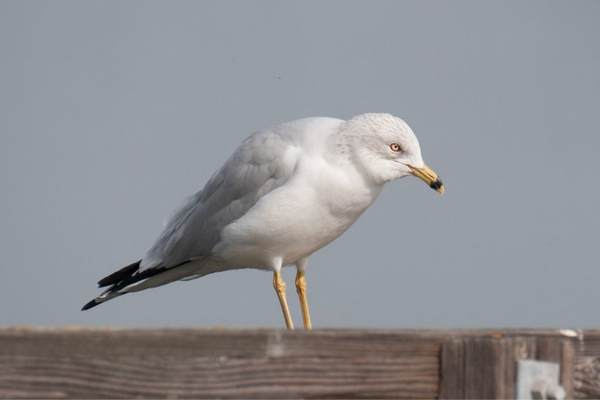
Scientific name: Larus delawarensis
The Ring-billed Gull is a common species in North America, but it’s also occasionally found in Hawaii. They are known for their white plumage, dark wingtips, and a black ring around their bill.
Ring-billed Gulls are a limited species in Hawaii, breeding during the spring and summer months. They typically nest on the ground or on man-made structures and lay 2-3 eggs per clutch. They are migratory, so they can be seen throughout the year in Hawaii, but mostly during the winter months.
Ring-billed Gull are found in a variety of habitats, including coastal areas, harbors, beaches and landfill sites. They feed on a variety of prey, including fish, crustaceans, insects and garbage. Their population is considered small in Hawaii and considered as vagrant.
20. Herring Gull
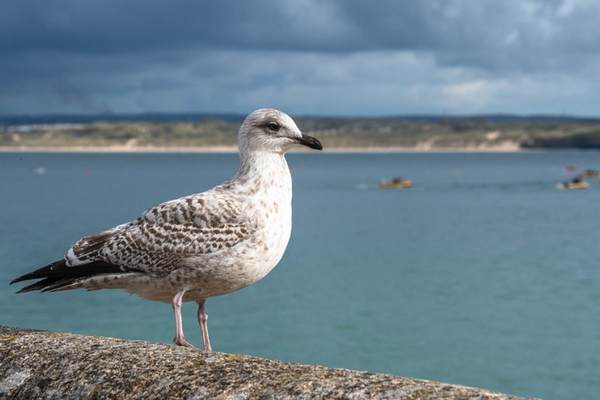
Scientific name: Larus argentatus
The Herring Gull is a large gull species that is known to be found in the Hawaiian islands. It is a migratory bird, typically seen in the islands during the winter months. They have gray and white feathers, with a pale gray back, white underparts and a red spot near the tip of their bills.
Herring Gull are known to be opportunistic feeders, feeding on fish, crustaceans, and garbage. They are typically found in coastal areas, including beaches, harbors, and landfills.
